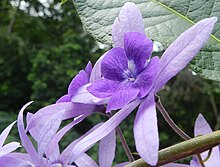Petrea volubilis
| Petrea volubilis | |
|---|---|

| |
| Scientific classification | |
| Kingdom: | Plantae |
| Clade: | Tracheophytes |
| Clade: | Angiosperms |
| Clade: | Eudicots |
| Clade: | Asterids |
| Order: | Lamiales |
| Family: | Verbenaceae |
| Genus: | Petrea |
| Species: | P. volubilis
|
| Binomial name | |
| Petrea volubilis | |
Petrea volubilis, commonly known as purple wreath, queen's wreath, sandpaper vine, and nilmani, is an evergreen flowering vine in the family Verbenaceae, native to Tropical America, that is valued especially for its display of violet flowers.[1][2]
Description[]

As a climbing plant, it grows to a height of 12 metres, but as a shrub it grows to 4 metres tall.[3] It is a vine or semi-climbing shrub with puberulent stems, sometimes reaching 10 cm in diameter. Leaves are elliptical-oblong, 5–16 cm long and 3–8 cm wide, apex acute or obtuse, base wedge-shaped, entire margin, sometimes sinuous, glabrous or pubescent, rough to the touch; petiole 0.2–1 cm long.[4][2]
The flowers emerge from bracts.[5] Racemose inflorescences 8–20 cm long, axillary or terminal, solitary, puberulent rachis, 5-mere flowers on puberulent pedicels supported by a deciduous bract ; calyx tube 0.2–0.7 cm long, glabrous or puberulent, corolla infundibuliform, 1 cm long, puberulent, blue; ovary and glabrous style. Drupaceous fruit completely enclosed in the acrid calyx which acts as wings or floats.
Distribution and habitat[]
It is found especially on the banks of rivers and streams, from northern Mexico to Bolivia, Brazil and Paraguay in the Antilles and in Venezuela. Depending on the climate, it can have up to two blooms in the year. Its very nectar-bearing flowers attract butterflies.[6]
Cultivation[]
In temperate climates, Petrea volubilis prefers full sun and it can tolerate shade, although it will not flower profusely. It handles a very light and fleeting frost at temperatures down to -2 °C, but beyond this threshold the plant would die. It thrives in well drained, fertile soils and can tolerate drought.[7]
The Wayapi ethnic group traditionally uses a preparation with sap to treat burns, wounds, inflammation and abscesses, and in the Caribbean it is used to treat diarrhea.[8]
References[]
- ^ "Petrea volubilis L. | Plants of the World Online | Kew Science". Plants of the World Online. Retrieved 2020-08-26.
- ^ a b "Petrea volubilis - Purple Wreath". www.flowersofindia.net. Retrieved 2019-04-12.
- ^ Petrea volubilis L. Verbenaceae Tropical Plants Database, Ken Fern. tropical.theferns.info. 2021-02-04.
- ^ Correa A., M. D., C. Galdames & M. N. S. Stapf. 2004. Cat. Pl. Vasc. Panamá 1–599. Smithsonian Tropical Research Institute, Panama.
- ^ https://botanyphoto.botanicalgarden.ubc.ca/2014/03/petrea-volubilis/ Retrieved 2020-09-19.
- ^ Funk, V. A., P. E. Berry, S. Alexander, T. H. Hollowell & C. L. Kelloff. 2007. Checklist of the Plants of the Guiana Shield (Venezuela: Amazonas, Bolivar, Delta Amacuro; Guyana, Surinam, French Guiana). Contr. U.S. Natl. Herb. 55: 1–584.
- ^ Petrea volubilis (queen's wreath) by Jeanine Vélez-Gavilán, University of Puerto Rico at Mayagüez, Puerto Rico from Centre for Agriculture and Bioscience International, 30 September 2019
- ^ Petrea volubilis - Pétrée volubile, Liane Saint Jean by Jardin L'Encyclopédie
External links[]
 Media related to Petrea volubilis at Wikimedia Commons
Media related to Petrea volubilis at Wikimedia Commons Data related to Petrea volubilis at Wikispecies
Data related to Petrea volubilis at Wikispecies
- Plants described in 1753
- Taxa named by Carl Linnaeus
- Verbenaceae